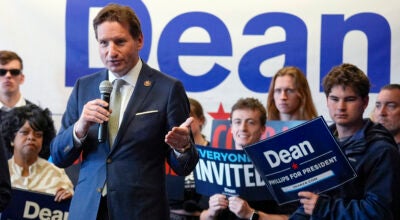Hodges leads Mpls. mayoral race
Published 9:05 am Wednesday, November 6, 2013
ST. PAUL — Minneapolis City Council member Betsy Hodges was voters’ runaway first choice to be her city’s next mayor. The question now is how many seconds and thirds she took.
Hodges was the top choice on 36 percent of ballots cast in Tuesday’s election, well ahead of former Hennepin County commissioner Mark Andrew’s nearly 25 percent. The city’s ranked choice voting requires election officials to eliminate losing candidates and redistribute second- and third-place choices in a system that ends when one candidate has more than 50 percent of the vote — a process not expected to be complete until today at the earliest.
Andrew seemed resigned to a loss, telling supporters Hodges would “be an excellent mayor.” Hodges, a budget chairwoman cultivated an image of fiscal stewardship, told her backers: “We aren’t there yet.”
They were among several Democrats who wanted to succeed R.T. Rybak, who didn’t seek a third term, as the leader of this heavily liberal city.
Rybak’s decision, along with the city’s paltry $20 filing fee, led to a massive ballot of 35 candidates. Voters were confounded further by the first real test of ranked choice voting, which eliminated the traditional primary that would have thinned the field.
“I miss being able to vote for one guy or one gal,” said Darryl Merwin, who voted Tuesday morning at a senior apartment building just north of downtown. Still, the retired maintenance worker dutifully ranked his top three candidates: a moderate Republican, an independent businesswoman and a Democratic member of the City Council.
“I have no idea if I did it right,” Merwin said.
In this off-year election, residents in several Minnesota cities were choosing mayors and council members. In St. Paul, incumbent Mayor Chris Coleman rolled to a third term in unofficial results.
In addition, 76 school districts were asking for some kind of financial help from voters through either operating, building or capital project levies.
But the most watched race was the muddled mayor’s race in Minneapolis. The low filing fee gave a host of oddball candidates a spot on the lengthy ballot: from an Occupy Wall Street activist named Captain Jack Sparrow, to frequent candidates Bob Carney and Ole Savior, to representatives of such unique political parties as Legacy-Next Generation, Local Energy/Food, and Pirate Party (oddly enough, not Captain Jack Sparrow).
Eight of the 35 candidates ran more traditional and well-funded campaigns. But Democratic activists left the race without a clear front-runner when they deadlocked last summer over whether to endorse Hodges or Andrew.
And Rybak, who last won re-election with nearly 73 percent of the vote, declined to endorse a successor.
Besides Hodges and Andrew, other leading candidates were Don Samuels, a city councilman; Jackie Cherryhomes and Dan Cohen, both past council presidents; Bob Fine, a member of the local park board; Stephanie Woodruff, a businesswoman; and Cam Winton, an attorney and moderate Republican.
Minneapolis residents approved ranked choice voting in a 2006 referendum.
It was sold as a progressive reform that eliminates the cost and burden of primary elections, and theoretically gives voters more say through the ranking system.
“I liked it. It was easier than I thought it would be,” said Connie Eiden, a retired program manager at the University of Minnesota whose top three choices were all Democrats. “There were a lot of opportunities to have it explained as long as you were paying attention.”
Under ranked choice, if no candidate exceeds 50 percent of first-choice votes, that triggers a series of automatic runoffs in which lower-ranked candidates are eliminated and second and third choices are redistributed to remaining candidates’ totals.
City election officials said the high number of candidates made it unlikely they would crown a winner until Wednesday at the earliest.





